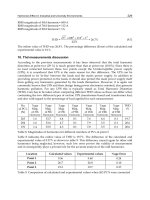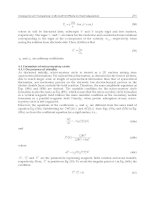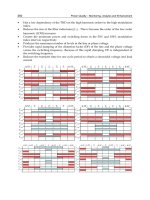Electrical Generation and Distribution Systems and Power Quality Disturbances Part 12 pot
Bạn đang xem bản rút gọn của tài liệu. Xem và tải ngay bản đầy đủ của tài liệu tại đây (2.51 MB, 20 trang )
9
Understanding Power Quality Based FACTS
Using Interactive Educational GUI
Matlab Package
Belkacem Mahdad and K. Srairi
Department of Electrical Engineering, Biskra University
Algeria
1. Introduction
The electricity is invisible and the complexity of mathematical models deviate the graduate
students attention from well understanding the underlying main concepts. Interactive
educational power system software has become a fundamental teaching tool because it
helps in particular the undergraduate students to assimilate theoretical issues and complex
models analysis through flexible graphic visualization of data inputs and the results (Abur
et al., 2000), (Milano, F., 2005). From the educational point of view software developed for
educational purposes should be flexible and interactive, easy to use and reliable. In
particular, software for power system education should contain a user interface not only to
allow graduate student to analyse and understand the physical phenomena, but also to
improve the existing models and algorithms (Mahdad, B., 2010 ).
Flexible AC Transmission Systems (FACTS) philosophy was first introduced by Hingorani
(Hingorani N. G., and Gyugyi L, 1999) from the Electric power research institute (EPRI) in
the USA in 1988, although the power electronic controlled devices had been used in the
transmission network for many years before that. The objective of FACTS devices is to bring
a system under control and to transmit power as ordered by the control centers, it also
allows increasing the usable transmission capacity to its thermal limits. With FACTS devices
we can control the phase angle, the voltage magnitude at chosen buses and/or line
impedances.
The avantages of the graphical user interface tool proposed lie in the quick and the dynamic
interpretation of the results and the interactive visual communication between users and
computer solution processes. The physical and technical phenomena and data of the power
flow, and the impact of different FACTS devices installed in a practical network can be
easily understood if the results are displayed in the graphic windows rather than numerical
tabular forms (Mahdad, 2010).
The application programs in this tool include power flow calculation based Newton-
Raphson algorithm, integration and control of different FACTS devices, the economic
dispatch based conventional methods and global optimization methods like Parallel Genetic
Algorithm (PGA), and Particle Swarm Optimization (PSO). In the literature many
educational Graphical tools for power system study and analysis developed for the purpose
of the power system education and training (Milano et al., 2005).
Electrical Generation and Distribution Systems and Power Quality Disturbances
208
Visual Results
GUI
Models/ Power
Flow, FACTS
Access to Code
Source
Reception
Communication : User/Matlab Package
Emission
Communication : User/Matlab Package
User
Fig. 1. Strategy for understanding power quality based FACTS technology
To carry out comprehensive studies on FACTS devices, to understand the basic principle of
FACTS devices, and to determine the role that FACTS technology may play in improving
power quality, it is mandatory to have an interactive educational tool using graphic user
interface based Matlab, this is the main object of this chapter. This chapter is limited to show
how the simplified software package developed works by showing the effects of the
introduction of different FACTS devices like shunt Controllers (SVC, STATCOM), series
Controllers (TCSC, SSSC) and the hybrid Controllers (UPFC) on a practical network under
normal and abnormal situation. Fig.1 shows the strategy for understanding power quality
based FACTS technology using an interactive graphical user interface (GUI).
2. Basic principles of power flow control
To facilitate the understanding of the basic principle of power flow control and to introduce
the basic ideas behind the different type of FACTS controllers, the simple model shown in
Fig. 2 is used (Mahdad, B., 2010). The sending and receiving end voltages are assumed to be
fixed. The sending and receiving ends are connected by an equivalent reactance, assuming
that the resistance of high voltage transmission lines is very small. The receiving end is
modeled as an infinite bus with a fixed angle of 0°.
~
jX
δ∠
s
V
0∠
R
V
Transmission Line
ij
I
i
j
s
S
R
S
Fig. 2. Model for calculation of real and reactive power flow control
Understanding Power Quality Based FACTS
Using Interactive Educational GUI Matlab Package
209
0 90 180
0
0.5
1
1.5
2
2.5
Active Power (P)
Stable
Unstable
Pmax
Fig. 3. Power angle curve
Complex, active and reactive power flows in this transmission system are defined,
respectively, as follows:
*
RR RR
SPjQVI=+ = (1)
max
sin sin
SR
R
VV
PP
X
δδ
==
(2)
2
cos
SR R
R
VV V
Q
X
δ
−
=
(3)
Similarly, for the sending end:
max
sin sin
SR
S
VV
PP
X
δδ
==
(4)
2
cos
SSR
S
VVV
Q
X
δ
−
=
(5)
Where
S
V and
R
V are the magnitudes of sending and receiving end voltages, respectively,
while δ is the phase-shift between sending and receiving end voltages. Fig. 3 shows the
evolution of the active power delivered.
It’s clear from the demonstrated equations, that the active and reactive power in a
transmission line depend on the voltage magnitudes and phase angles at the sending and
receiving ends as well as line impedance.
Electrical Angle (δ) (degree)
Electrical Generation and Distribution Systems and Power Quality Disturbances
210
2.1 Example of power flow control
The concepts behind FACTS controller is to enable the control of three parameters which
are:
1. Voltage magnitude (V)
2. Phase angle (δ)
3. And transmission line reactance (X) in real-time and, thus vary the transmitted power
according to system condition.
ij
P⊕
ij
P−
ij
Q−
ij
Q⊕
i j
ij
P
ij
Q
i
Q
V
i
Fig. 4. Three vector control structure (Voltage control -Active power control - Reactive
power control) based FACTS technology
The ability to control power rapidly, within appropriately defined boundaries, can increase
transient and dynamic stability as well as the damping of the system.
The following section illustrate the basic principle of the FACTS Controllers designed to be
integrated in a practical network. Fif. 4 shows the three mode control related to FACTS
compensators.
~
~
~
~
X/2
X/2
Iq
Iq
Vr
Vs
Vm+Vp
Vm
Vpq
Fig. 5. Generalized schematic of power flow controller
The simplified genralized power flow controller consists of two controllable elements, a
voltage source (
pq
V ) inserted in series with the line, and a current source (
q
I ), connected in
Understanding Power Quality Based FACTS
Using Interactive Educational GUI Matlab Package
211
shunt with the line at the midpoint. The four classical cases of power transmission are
considered:
1. Without line compensation,
2. With series compensation,
3. With shunt compensation,
4. and with phase angle control.
The different operation mode can be obtained by appropriately specifying
pq
V and
q
I in the
generalized schematic power flow controller is shown in Fig. 5.
Case 1 Power flow controller is off. Then the power transmitted between the sending and
receiving end generators can be expressed by:
2
1
sin( )
l
V
P
X
δ
= (6)
Where δ is the angle between the sending and receiving-end voltage phasors.
Case 2 Assume that 0
q
I = and
pq
VjkXI=− , the voltage source acts at the fundamental
frequency precisely as a series compensating capacitor. The degree of series compensation is
defined by coefficient k ( 0 1k≤≤), the relationship between P and δ becomes:
2
2
sin( )
(1 )
V
P
Xk
δ
=
−
(7)
Case 3 The reactive current source acts like an ideal shunt compensator which segments the
transmission lines into independent parts, each with an impedance of X/2, by generating
the reactive power necessary to keep the mid-point voltage constant, independently of angle
δ, for this case the relationship between P and δ becomes:
2
3
2
sin( )
2
V
P
X
δ
= (8)
0 20 40 60 80 100 120 140 160 180
0
0.5
1
1.5
2
2.5
3
3.5
4
Electrical Angle
Active Power Transit
1
2
3
normal
shunt compensation
serie compensation
Fig. 6. Active power transit with different compensation types
Electrical Generation and Distribution Systems and Power Quality Disturbances
212
Case 4
The basic idea behind the phase shifter is to keep the transmitted power at a desired
level independently of angle δ in a predetermined operating range. Thus for example, the
power can be kept at its peak value after angle δ exceeds π/2, by controlling the amplitude
of quadrature voltage
pq
V . Fig. 6 shows the evolution of active power transit based different
compensation types.
2
4
sin( )
V
P
X
δα
=+ (9)
2.2 Role of FACTS devices in power system operation and control
To further understand the strategy of FACTS devices in power system operation and
control, consider a very simplified case in which generators at two different regions are
sending power to a load centre through a network consisting of three lines.
Fig. 7 shows the topology of simple electrical network, suppose the lines 1-2, 1-3 and 2-3
have continuous ratings of 1000MW, 2000MW, and 1250MW, respectively, and have
emergency ratings of twice those numbers for a sufficient length of time to allow
rescheduling of power in case of loss of one of these lines (Hingorani, N. G., and Gyugyi L,
1999).
For the impedances shown, the maximum power flow for the three lines are 600, 1600, and
1400, respectively, as shown in Fig. 7, such a situation would overload line 2-3 (loaded 1600
MW for its continuous rating of 1250 MW), and there for generation would have to be
decreased at unit 2, and increased at unit 1, in order to meet the load without overloading line
2-3. The following simplified studies cases demonstrate the main objective of integration of
FACTS technology in a practical power system to enhance power system security.
Load
3000MW
G1
1
2
3
2000MW
1000MW
600 MW
1400 MW
1600 MW
10 Ω
5 Ω
10 Ω
G2
60%
70%
128%
Overload at line 2-3
1000
MW
2000 MW
1250 MW
Risk o f Black out
Fig. 7. Topology of the electrical network 3-bus with technical characteristics without
dynamic compensators
Understanding Power Quality Based FACTS
Using Interactive Educational GUI Matlab Package
213
Case 1: Capacitive Series Compensation at line 1-3
If the dynamic series FACTS Controller (type capacitive)installed at line 1-3 adjusted to
deliver a capacitive reactance, it decreases the line’s impedance from 10Ω to 4.9919Ω, so that
power flows through the lines 1-2, 1-3, and 2-3 will be 250 MW, and 1750 MW, respectively.
Fig. 8 illustrates the per cent loading of lines. It is clear that if the series capacitor is
adjustable, then other power flow levels may be realized in accordance with the ownership,
contract, thermal limitations, transmission losses, and wide range of load and generation
schedules. Fig. 8 shows clearly the effect of series capacitive compensation to control the
active power flow with another degree of compensation (
6
C
X =Ω).
G1
1
2
3
2000MW
1000MW
Load
3000MW
250 MW
1750 MW
1250 MW
G2
25%
87.50%
100%
Xc=5.0081 Ω
Series FACTS Controller
Fig. 8. Load flow solution with consideration of dynamic compensators: Case1
G1
1
2
3
2000MW
1000MW
Load
3000MW
158.27 MW
1841.73 MW
1158.27MW
G2
Xc=6 Ω
92.09%
15.83%
92.66%
Series FACTS Controller
Fig. 9. Load flow solution with consideration of dynamic compensators: Case1
Electrical Generation and Distribution Systems and Power Quality Disturbances
214
Case 2: Inductive Series Compensation at line 2-3
If the dynamic series FACTS Controller (type inductive) installed at line 2-3 adjusted
dynamically to deliver an inductive reactance, it increase the line’s impedance from 5 Ω to
12.1Ω, so that power flows through the lines 1-2, 1-3, and 2-3 will be 248.22 MW, 1751.78
MW and 1248.22 MW, respectively.
Load
3000MW
G1
1
2
3
2000MW
1000MW
248.22 MW
1751.78 MW
1248.22 MW
G2
XL=7.1 Ω
24.82%
99.86%
87.59%
Series FACTS Controller
Fig. 10. Load flow solution with consideration of dynamic compensators: Case2
Load
3000MW
G1
1
2
3
2000MW
1000MW
210.33 MW
1789.67 MW
1210.33 MW
G2
XL=8.1 Ω
21.03%
96.83%
89.48%
Series FACTS Controller
Fig. 11. Load flow solution with consideration of dynamic compensators: Case2
It is clear from Fig. 9 and Fig. 10, that if the series inductance is adjustable, then other power
flow levels may be realized in accordance with the ownership, contract, thermal limitations,
transmission losses, and wide range of load and generation schedules.
Understanding Power Quality Based FACTS
Using Interactive Educational GUI Matlab Package
215
As we can see from simulation results depicted in different Figures; the location of series
FACTS devices affect significtly the perfermances of power system in term of lines loading
and total power losses.
2.3 Basic types of FACTS controllers
In general, FACTS Controllers can be classified into three categories (Hingorani, NG., and
Gyugyi L, 1999) :
•
Series Controllers
•
Shunt Controllers
•
Combined series-shunt Controllers
a. Series Controllers
In Fig. 12 the series controllers could be variable impedance, such as capacitor, reactor, etc.,
in principle; all series controllers inject voltage in series with the line. Even variable
impedance multiplied by the current flow through it, represents an injected series voltage in
the line. As long as the voltage is in phase quadrature with the line current, the series
Controller only supplies or consumes variable reactive.
P Power flow control
Bus i
Bus J
Fig. 12. Series Controller
b. Shunt Controllers
In Fig. 13 as in the case of series Controllers, the shunt controllers may be variable
impedance, variable source, or a combinaison of these.
+Q
-Q
V
r
Voltage Control
Bus i
Bus J
Fig. 13. Shunt Controller
In principle, all shunt controllers inject current into the system at the point of connection.
Even a variable of shunt impedance connected to the line voltage causes a variable current
flow and hence represents injection of current into the line (Mahdad, 2010).
c. Hybrid Controllers (Combined series-shunt)
This could be a combination of separate shunt and series compensators, which are
controlled in coordinated manner, or a unified power flow with series and shunt elements.
Electrical Generation and Distribution Systems and Power Quality Disturbances
216
In Fig. 14 combined shunt and series controllers inject current into the system with the shunt
part of the controller and voltage in series in the line with the series part of the controller.
However, when shunt and series controllers are unified, there can be a real power exchange
between the series and shunt controllers via the power link (Achat et al., 2004).
ij
P⊕
ij
P−
ij
Q−
ij
Q⊕
+Q
-Q
V
r
Dc Power
Link
P, Q
Voltage Control
Power Control
Bus J
Bus i
Fig. 14. Unified series-shunt Controller
3. FACTS modeling
Since their apparition, many models of FACTS devices are proposed by researchers to
improve the power quality delivered to consumer, the proposed models are integrated in
the standard power flow problem, and to the optimal power flow problem. The objective of
this section is to investigate the integration of many types of FACTS controllers (shunt, series,
and hybrid Controllers) in a practical electrical network to enhance the power quality.
3.1 Static VAR Compensator (SVC)
The steady-state model proposed by Acha et al. (Achat et al., 2004) is used here to
incorporate the SVC on the standard power flow problems based Newton Raphson. This
I
L
C
L
C
TSC
TCR
Filter
Shunt
Trans
f
ormer
Fig. 15. Static var Compensator (SVC)
Understanding Power Quality Based FACTS
Using Interactive Educational GUI Matlab Package
217
model is based on representing the controller as a variable impedance, assuming an SVC
configuration with a fixed capacitor (FC) and Thyristor-controlled reactor (TCR) as depicted
in Fig. 15, the controlling element is the Thyristor valve. The thyristors are fired
symmetrically, in an angle control range of 90 to 180 with respect to the capacitor (inductor)
voltage. Fig. 16 shows the two SVC models basic representation.
Power Flow
V
r
O
min
B
max
B
b) Susceptance Model
a) Firing angle Model
V
r
O
min
α
max
α
Fig. 16. Two SVC models representation
3.2 Unified Power Flow Controller (UPFC)
An equivalent circuit of the UPFC as shown in Fig. 17 can be derived based on the operation
principle of the UPFC (Achat et al., 2004) , (Mahdad et al., 2005).
m
V
m
I
Bus k
Bus
m
~
vR
E
vR
I
vR
Y
cR
Y
cR
E
k
V
1
I
k
I
{}
0Re
**
=+
mcRvRvR
IEIE
Fig. 17. Equivalent circuit based on solid state voltages sources
The UPFC equivalent circuit described in Fig. 17 is represented by the following voltage
sources:
() ()
()
cos sin
vR vR vR vR
EV j
δδ
=+
(10)
() ()
()
cos sin
cR cR cR cR
EV j
δδ
=+ (11)
Where
vR
V and
cR
V are the controllable magnitude,
Electrical Generation and Distribution Systems and Power Quality Disturbances
218
min max
vR vR vR
VVV≤≤ , and phase angle,
02
vR
δπ
≤≤of the voltage source representing the shunt converter. The magnitude
cR
V and
phase angle
cR
δ
of the voltage source representing the series converter are controlled
between limits:ij
min max
cR cR cR
VVV≤≤ , and 02
cR
δπ
≤≤.
3.3 Thyristor Controlled Reactor (TCSC)
The TCSC power flow model presented in this section is based on the simple concept of a
variable series reactance, the value of which is adjusted automatically to constrain the power
flow across the branch to a desired value.
reg
ft
P
f t
Capacitive Operative
t
reg
ft
P
f
Inductive Operative
I
t
C
L
V
f
V
t
I
f
X
TCSC
Fig. 18. Principle of thyristor controlled series capacitor (TCSC)
The amount of reactance is determined efficiently using Newton’s method. The changing
reactance shown in Fig. 18 represents the equivalent reactance of all the series connected
modules making up the TCSC, when operating in either the inductive and capacitive region.
The equivalent reactance of line
i
j
X is defined as:
i
j
line TCSC
XX X=+ (12)
Where,
line
X is the transmission line reactance, and
TCSC
X is the TCSC reactance. The level of
the applied compensation of the practical TCSC usually between 20% inductive and 80%
capacitive.
4. Understanding power quality based FACTS controllers using FACTS
Simulator (SimFACTS Power Flow package)
The advantages of the proposed graphical user interface tool lie in the quick and the
dynamic interpretation of the results and the interactive visual communication between
users and computer solution processes. The physical and technical phenomena and data of
the power flow, and the impact of different FACTS devices installed in a practical network
can be easily understood if the results are displayed in the graphic windows rather than
Understanding Power Quality Based FACTS
Using Interactive Educational GUI Matlab Package
219
numerical tabular forms. Fig. 19 illustrates the components of the proposed strategy based
FACTS technology. The SimFACTS tool includes the following application programs:
•
Power flow calculation based Newton-Raphson algorithm
•
Understanding power quality based FACTS devices
•
Voltage Stability based continuation power flow (CPF)
•
Economic dispatch based conventional methods and global optimization methods like
Genetic Algorithm (GA), and Particle Swarm Optimization (PSO).
Data base
Ybus
Modified
Jacobian
FACTS
Models
FACTS
Location
CPF
NR
mod
43
21
⎥
⎦
⎤
⎢
⎣
⎡
JJ
JJ
Convergence
No
Yes
• Power Flow Solution
• Indices of power Quality
• Voltage deviation
• Power loss
• Power transit limits
M_Newton
M_Rvoltage
M_branch
M_Rstability
M_Mdl_FACTS
M_SVC
M_TCSC
M_UPFC
M_STATCOM
M_Bus
M_Data
M_Branch
M_FACTS
M_Plot
Matlab Functions
Shunt Series Hybrid
Critical
buses
Fig. 19. Flowchart of the proposed basic SimFACTS
Electrical Generation and Distribution Systems and Power Quality Disturbances
220
Fig. 20. The package for FACTS modelling and analysis (SimFACTS) with three languages:
Arabic, English and French
In the literature many educational Graphical tools for power system study and analysis
developed for the purpose of the power system education and training ().
This section reveals how the software package developed works by showing the effects of
the introduction of different FACTS devices like the SVC, STATCOM, TCSC, SSSC and the
UPFC Controllers. Fig. 20 shows the global functionality of the package graphical user
interface based Matlab as a tool to demonstrate the impact of FACTS devices on power
system operation and control.
4.1 Structure of SimFACTS
A working main screen appears as shown in Fig. 20, first the user asked to choose the
working language: Arabic, English or French.
The functions of the menus are:
•
File: To do standard file storage or retrieve files for operations.
•
Network Configuration: To display data of the network test system, make changes,
display the topology.
•
Power Flow: This is the standard application calculation part: the Newton Raphson
algorithm included to calculate the power flow; user has to click to ‘Power Flow’ after
Understanding Power Quality Based FACTS
Using Interactive Educational GUI Matlab Package
221
data entry. The submenu ‘FACTS Controller’ designed to enter in details the data base
of the different FACTS Controllers.
•
Optimal Power Flow: In this version (ver.1.0): the user can calculate the OPF using
three methods:
•
Basic economic dispatch based Lagrange method
•
Simple Genetic Algorithm (SGA)
•
Particle swarm Optimization (PSO)
•
Reactive Power Control: In this version (ver.1): the user can choose the FACTS
controllers to control the reactive power at a specified location.
•
Voltage Stability Analysis based Continuation Power Flow: this section alows user to
test the impact of FACTS devices in voltage stability and system loadability using
continuation power flow analysis.
•
Results: This is an option provided for the user to view all results.
•
Help: The objectives, scope and functions of each of the components are briefly given
in this option.
Fig. 21. Structure of the developed simulator incorporating FACTS devices
The Newton-Raphson algorithm modified based on the FACTS models and used to
calculate all the necessary electrical values involved on the power flow study. The simple
software proposed is capable of doing simulations for several models of FACTS controllers
at different power system situation.
Electrical Generation and Distribution Systems and Power Quality Disturbances
222
4.2 Graphic User Interface tool (GUI)
The MATLAB graphical user interface development environment, provides a set of tools for
creating graphical user interfaces (GUIs). These tools greatly simplify the process of
designing and building GUIs. We can use the GUIDE tools to:
Lay out the GUI. Using the GUIDE Layout Editor, the user can lay out a GUI easily by
clicking and dragging GUI components such as panels, buttons, text fields, sliders, menus,
and so on into the layout area. GUIDE stores the GUI layout in a FIG-file.
4.3 Program the GUI
GUIDE automatically generates an M-file that controls how the GUI operates. The M-file
initializes the GUI and contains a framework for the most commonly used callbacks for each
component the commands that execute when a user clicks a GUI component. Using the M-
file editor, we can add code to the callbacks to perform the functions the user want. Fig. 22
shows the structure of the object, Fig. 23 shows the different Object contained in a GUI.
Type of Files: *.m and *.fig
Object
Proprieties
Callback
Fig. 22. Object structure
Edit
Line
Axes
Slider
Button
Checkbox Text
Figure
Interface
Object
Fig. 23. Different Object of the GUIDE
Understanding Power Quality Based FACTS
Using Interactive Educational GUI Matlab Package
223
4.4 Power flow program based FACTS (SimFACTS)
The interactive FACTS program proposed is implemented in a MATLAB environment,
using the GUI tool; the Simulator is capable of doing simulations for several models of
FACTS Controllers. First the program allows users to choose the working language (French,
Arabic or English) Fig. 21 shows the global interface to simulate the integration of different
FACTS Controllers in a practical network. The user may either retrieve an existing pre-
saved system data or start a new system formulation; due to the limited pages we only
present an example of UPFC interface description. Fig. 24 displaying the UPFC parameters
to be entered and adjusted by user. For example The UPFC Controller data base parameters
are:
•
The insertion point
•
The power flow: determines the direction of the flowing power
•
Inductive reactance of Series impedance
•
Inductive reactance of Shunt impedance
•
Active Power Control status
•
Reactive power control status
•
Active power desired
•
Reactive power desired
•
Series voltage amplitude
•
Shunt voltage amplitude
•
Operational limits of the series and shunt voltage
Fig. 24. UPFC parameters input data window
Electrical Generation and Distribution Systems and Power Quality Disturbances
224
5. Simulation test and results using SimFACTS
The FACTS models integrated in the proposed educational power system control are those
proposed by (Achat et al., 2004), and by Canizares (Canizares, C. A, at al., ). The Newton-
Raphson algorithm is used to calculate all the electrical values involved in power system
The FACTS simulation package is capable of doing interactive simulations for several types
of controllers as shown in Table 1.
Using this simplified and interactive program, user can easely understand the basic concept
of this new technolgy based FACTS devices introduced to power system operation and
control. During simulation user can access directly to the code source program of any
desired function (Ybus, Newton-Raphson, SVC Model, STATCOM model, TCSC Model,
UPFC Model, Graphic functions,) , user also can modify the content of existant models, and
test the efficiency of the modiefd models.
Topology Model Identification
Shunt
STATCOM Model
SVC with Variable Susceptance Model
SVC with Firing Angle Model
Series
SSSC Model
TCSC with Variable Reactance Model
TCSC with Variable Firing Angle Model
Combined (Hybrid)
UPFC Model
Table. 1. List of FACTS models used in the first version (V1.0) of the SimFACTS package
5.1 Demostration example using SVC controller
The two SVC models based susceptance values and firing angle are included in the FACTS
Simulator; the two models can be applied to a different practical power systems (smal,
medium and large test systems). To understand the real contribution of the shunt FACTS
controller (SVC) to enhance the power quality, the shunt controller integrated in a practical
modified electrical network, IEEE 30-Bus. Voltage deviation ( VΔ ) power loss (
loss
P
), active
power branch flow (
i
j
P ), and system loadability (
λ
), are the indices of power quality
considred to demonstrate the improvement of power quality, to validate the flexibilite, and
the simplicity of the proposed educational SimFACTS package based Matlab.
Fig. 25 shows the improvement of voltages profiles using multi SVC controllers installed at
8 buses. Fig. 26 shows the evolution of voltage profiles at all buses based continuation
power flow without SVC integration, the loading factor is 2.9449 p.u. By integration SVC
Controllers at 8 critical buses, the loading factor improved to 3.1418 p.u. Fig. 27 shows
clearly the contribution of shunt FACTS controllers to improve the power system
loadability. Details results related to the integration of series controllers (TCSC, SSSC) and
hybrid controllers (UPFC) will be given in the next contribution.
Understanding Power Quality Based FACTS
Using Interactive Educational GUI Matlab Package
225
0 5 10 15 20 25 30
0.95
1
1.05
1.1
Bus N°
Voltage (p.u.)
Without SVC
With SVC
Fig. 25. Voltage profiles normal condition: case: with and without SVC installation.
NSVC=8: (10-17-19-21-22-24-27-29)
0.5 1 1.5 2 2.5
0.5
0.6
0.7
0.8
0.9
1
1.1
1.2
Loading Parameter
λ
(p.u.)
Voltage (p.u)
Bus1
Bus2
Bus3
Bus4
Bus5
Bus6
Bus7
Bus8
Bus9
Bus1
0
Bus11
Bus1
2
Bus1
3
Bus1
4
Bus1
5
Bus1
6
Bus1
7
Bus1
8
Bus1
9
Bus2
0
Bus21
Bus2
2
Bus2
3
Bus2
4
Bus2
5
Bus2
6
Bus2
7
Bus2
8
Bus2
9
Bus30
Without Compensation
λ
=2.9449 p.u
Fig. 26. Voltage profiles with continuation power flow: case: Without SVC
Electrical Generation and Distribution Systems and Power Quality Disturbances
226
0.5 1 1.5 2 2.5 3
0.5
0.6
0.7
0.8
0.9
1
1.1
1.2
1.3
Bus1
Bus2
Bus3
Bus4
Bus5
Bus6
Bus7
Bus8
Bus9
Bus10
Bus11
Bus12
Bus13
Bus14
Bus15
Bus16
Bus17
Bus18
Bus19
Bus20
Bus21
Bus22
Bus23
Bus24
Bus25
Bus26
Bus27
Bus28
Bus29
Bus30
With Compensation (SVC)
Loading Parameter
λ
(p.u.)
Voltage (p.u)
λ
=3.1418 p.u
Fig. 27. Voltage profiles with continuation power flow: case: With SVC installation:
NSVC=8: (10-17-19-21-22-24-27-29)
0 0.5 1 1.5 2 2.5 3 3.5
0.5
0.6
0.7
0.8
0.9
1
1.1
1.2
1.3
Without SVC
With SVC
Loading Parameter
λ
(p.u.)
Voltage (p.u)
Fig. 28. Voltage profiles improvement at critical bus (bus 30) with continuation power flow:
case: With and without SVC installation: NSVC=8: (10-17-19-21-22-24-27-29)









